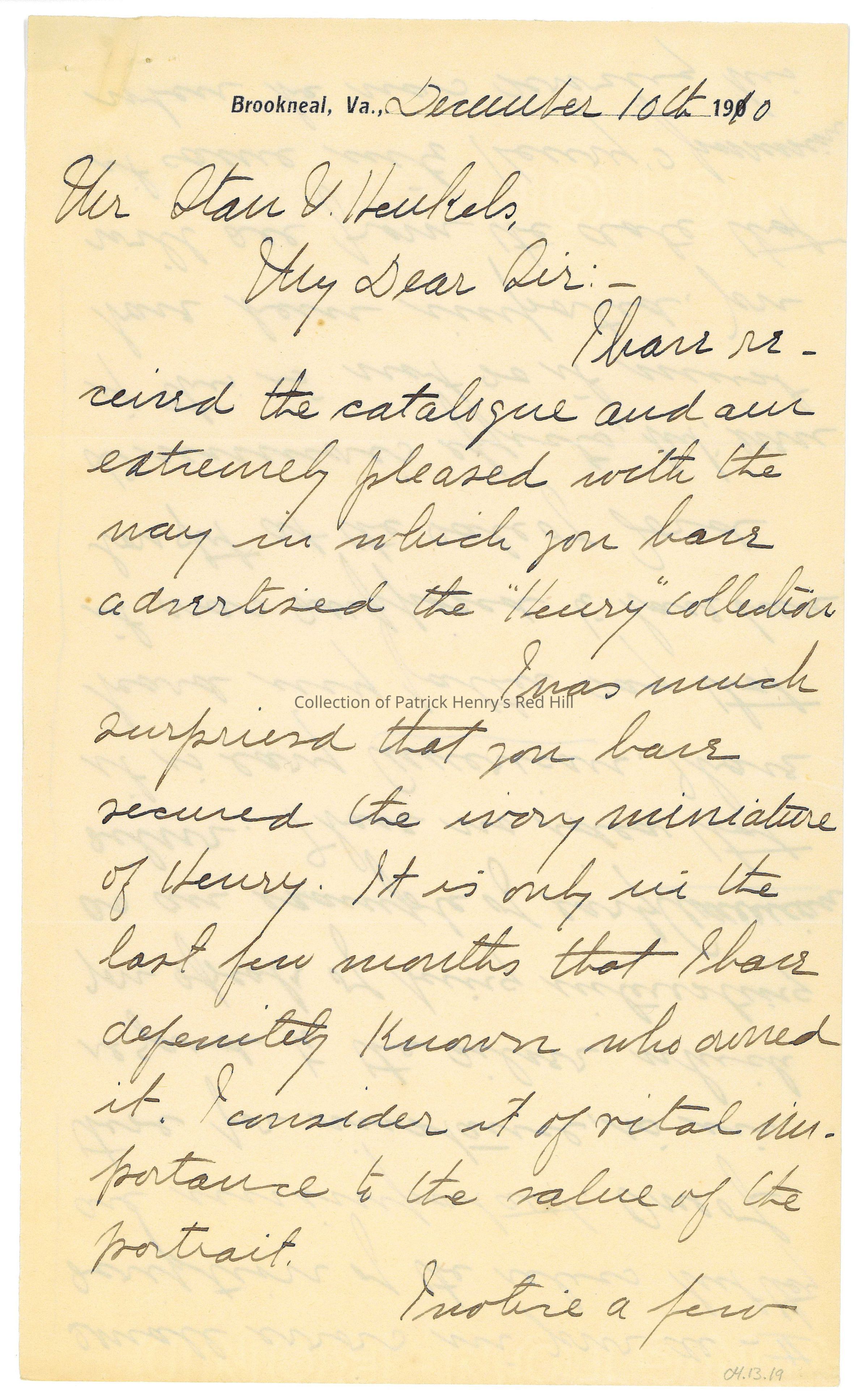Notes
This letter belongs to a collection of correspondence primarily from Lucy Gray Henry Harrison (1857–1944) to Stanislaus “Stan” Vincent Henkels (1854–1926) concerning a proposed sale of Patrick Henry family heirlooms in 1910. Mrs. Harrison was Patrick Henry's great-granddaughter and the last Henry descendant to own and live at Red Hill. She grew up in Richmond, Virginia, and moved to Duluth, Minnesota, after marrying real estate millionaire Matthew Bland Harrison (1853–1892) in 1886. In 1905, she inherited Red Hill and moved onto the property, where she lived along with her sister, Elizabeth Watkins Henry Lyons (1855–1920), and her assistant, Elizabeth H. Kerper (1890–1964).
Mrs. Harrison inherited many of the family heirlooms that had belonged to Patrick Henry and many of his papers. In 1910, on the advice of Philadelphia neurologist and writer Dr. Weir Mitchell (1829–1914), she contacted Stan V. Henkels about a possible private sale or public auction of some of these pieces. Mr. Henkels was an antique dealer in Philadelphia well-known for his auctions and private sales to collectors. The correspondence from Mrs. Harrison to Mr. Henkels details their business negotiations from May 1910 leading up to the sale of the items in Philadelphia on December 20, 1910. It also includes letters concerning a settling of accounts between them up through February 1911.
The auction catalog compiled by Mr. Henkels lists and describes the Patrick Henry papers and heirlooms Mrs. Harrison had sent, along with a few historical items unrelated to Henry that were up for sale at the same auction. Charles L. Hamilton (1847–1930), who purchased many Patrick Henry items, owned a copy of this catalog (76.5.2), which his heirs donated to the Patrick Henry Memorial Foundation in 1959.
The ivory miniature of Henry was painted from life in 1795 by Lawrence Sully (1769–1804). The miniature passed through the family of Patrick Henry’s older half-brother, John Syme Jr. (1727–?), and in 1910, was owned by Syme’s great-grandson, John Syme Fleming Jr. (1842–1922). Mr. Fleming sent it to auction at the same 1910 sale that Mrs. Harrison sent her Henry heirlooms to. It was sold at auction for $660 to Gilbert Sunderland Parker (1861–1921), the curator of paintings at the Pennsylvania Academy of the Fine Arts. At some point, it passed into the possession of Herbert Lee Pratt (1871–1945), who left it to Amherst College in 1945.
Lawrence Sully’s miniature was used as the visual basis for an 1815 portrait of Henry by Lawrence’s brother, Thomas Sully (1783–1872). Thomas Sully’s portrait is an oil painting on canvas commissioned by Henry’s first biographer, William Wirt (1772–1834). An engraving of the portrait was featured on the frontispiece of Wirt’s 1817 biography, “Sketches of the Life & Character of Patrick Henry.” Thomas Sully’s portrait of Henry was given by Wirt to Henry’s youngest son, John (1796–1868), who passed the portrait on to his son William Wirt Henry (1831–1900), who loaned it to the Virginia State Library in Richmond from 1873 to 1884 before he passed it on to his daughter, Lucy Harrison. In 1902, Mrs. Harrison loaned the portrait again to the Virginia State Library but reclaimed it in 1910 to sell it at Mr. Henkels’ auction, where it was purchased by Charles Hamilton for $4,000. The Colonial Williamsburg Foundation later purchased the portrait from the Hamilton family and currently has it in its collection.
The silver caster set (96.1.1-6) owned by Patrick Henry is in the Red Hill collection. It is not early American silver, as Mr. Henkels thought, but was made circa 1733 by London silversmith Thomas Rush. Henry may have purchased the casters at the 1776 sale of the belongings of John Murray, 4th Earl of Dunmore (1730–1809), as Mrs. Harrison mentions in this letter. Henry’s initials, along with the year “1777,” are inscribed on each piece of the caster set, which may have been done in commemoration of either Patrick and Dorothea Henry’s wedding or of the start of Henry’s second term as governor. The set was sold to Charles Hamilton for $200 at the December 1910 auction.
The Patrick Henry Memorial Foundation purchased this letter from an online seller in May 2004 as part of the collection of correspondence.
